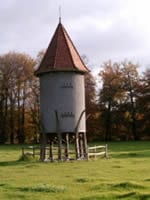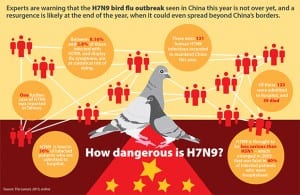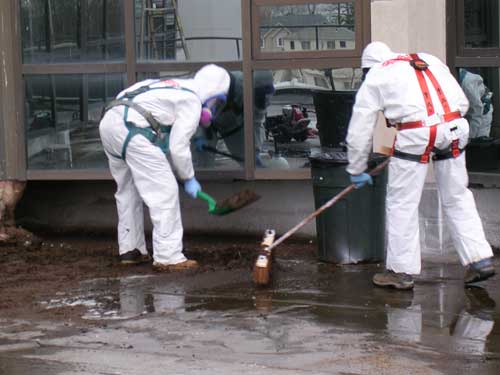
by Pigeon Patrol | May 4, 2014 | Bird Deterrent Products, Pigeons in the News, UltraSonic Bird Control
 The lethal control of birds is prohibited under the The Wildlife and Countryside Act 1981 unless the species concerned is listed under the relevant section of the Act. Although specific licences are required for some methods of lethal control, such as the use of stupefying baits, the most commonly controlled species of pest birds (such as the feral pigeon) are allowed to be killed under a General Licence. This means that providing an ‘authorised person’ undertakes the culling and providing that the culling is undertaken in accordance with the guidelines laid down by the General Licence, a specific application to kill is not required. All licences are issued and overseen by The Department for Environment, Food and Rural Affairs (DEFRA) including the General Licence.
The lethal control of birds is prohibited under the The Wildlife and Countryside Act 1981 unless the species concerned is listed under the relevant section of the Act. Although specific licences are required for some methods of lethal control, such as the use of stupefying baits, the most commonly controlled species of pest birds (such as the feral pigeon) are allowed to be killed under a General Licence. This means that providing an ‘authorised person’ undertakes the culling and providing that the culling is undertaken in accordance with the guidelines laid down by the General Licence, a specific application to kill is not required. All licences are issued and overseen by The Department for Environment, Food and Rural Affairs (DEFRA) including the General Licence.
Lethal control has been used as a ‘quick-fix’ means of reducing pigeon numbers for as long as there has been a need to control the species. The pest control industry has historically recommended lethal controls alongside the provision of anti-perching and bird exclusion products in an effort to maximise relief for those experiencing pigeon-related problems. Although the installation of anti-perching products (and some bird exclusion products) will resolve a vast majority of pigeon-related problems without the need for additional controls, many pest control companies still recommend lethal control either as a complementary service or as a stand-alone control.
Based on the evidence that culled birds are replaced within a matter of weeks following a cull, culling cannot be used, under any circumstances, to reduce flock size in anything other than the short-term. If a property owner is expected to undertake a cull every few weeks in order to protect his/her property, the cost of the service would be prohibitive. Even in light of these facts, culling is still widely recommended and used by the pest control industry as a method of control. The following methods are commonly used to cull pigeons:
Cage Trap for Killing Pigeons
A suitable area is identified in which to site the trap that is easy to access for the pest control contractor and which is considered to be in an area of high pigeon activity. Other criteria, such as finding a site that is not overlooked, is equally important as the general public find the sight of trapped birds extremely distressing. The cage trap is then baited with pigeon corn for approximately 7 days, allowing pigeons’ free access to enter the trap, feed and then exit the trap. This process is designed to make the birds feel safe whilst feeding within the trap so that after 7 days when the trap is set, the maximum number of birds will be caught. The trap has a two-way door which, when set, allows the pigeon to enter the trap but not to exit it. The trap is then visited once a day and any birds within the trap are removed and either killed on the site or removed live, normally in a sack and taken away to be gassed.
Cage trapping is also highly labour intensive, resulting in higher costs to the client due to the fact that the law states that as a minimum, cage traps must be inspected once every 24 hours. Although the law is quite clear on this point, not all contractors comply with this legislation and empty their traps every 24 hours. If the contractor fails to inspect and empty their traps every 24 hours they run the risk of prosecution, as does the client upon whose site the traps are located. There is also a legal requirement to provide food and water in cage traps but again, not all contractors comply with this aspect of the legislation. 
Rifle Used for Killing Pigeons
Shooting operations are normally undertaken at night with daytime shoots only being used in agricultural applications or for specialised urban applications. In urban applications, pigeons are usually shot at night and in their roosting sites because the birds are unable to fly away when the shooting starts, as they would if shoots were undertaken in daylight hours. The major problem inherent with shooting operations is the inability of the shooter to recover and dispatch injured birds. It is virtually impossible to kill a pigeon outright with an air weapon and therefore a majority of birds are simply shot and injured. Because pigeons normally roost at height and because when shot, a pigeon will be pushed backwards with the impact of the pellet entering the body, very few injured pigeons actually fall to the ground. This means that injured birds cannot be dispatched humanely, as is required by law, to prevent suffering taking place, rendering this method of lethal control inhumane. A pigeon can survive for weeks with a pellet lodged in its body and will suffer a slow and lingering death as a result. Also, in situations where a majority of the seriously injured birds cannot be humanely dispatched, the property owner upon who’s site the shooting has taken place will inevitably experience unpleasant smells and maggot infestations as birds die in their roosting places.
About Pigeon Patrol:
Pigeon Patrol Products & Services is the leading manufacturer and distributor of bird deterrent (control) products in Canada. Pigeon Patrol products have solved pest bird problems in industrial, commercial, and residential settings since 2000, by using safe and humane bird deterrents with only bird and animal friendly solutions. At Pigeon Patrol, we manufacture and offer a variety of bird deterrents, ranging from Ultra-flex Bird Spikes with UV protection, Bird Netting, 4-S Gel and the best Ultrasonic and audible sound devices on the market today.
Voted Best Canadian wholesaler for Bird Deterrent products four years in a row.
Contact Info: 1- 877– 4– NO-BIRD (www.pigeonpatrol.ca)
The information on this blog is for personal use only. Content for this blog obtained from other websites is not being used for any commercial reasons whatsoever as per the copyright statement on the Pigeon Control Resource Centre’s website. http://www.pigeoncontrolresourcecentre.org/ Special thanks for the people and companies that helped gather this information. This information is to be used for reference only.

by Pigeon Patrol | May 4, 2014 | 4-S Gel Bird repellent, Bird Deterrent Products, Bird Netting, Pigeon Patrol's Services, Pigeon Spikes, Pigeons in the News, UltraSonic Bird Control
 The use of artificial breeding facilities (ABFs) such as dovecotes or pigeon lofts as a method of pigeon control is becoming increasingly popular in Europe with many users experiencing astonishing results. This control was pioneered by the Pigeon Control Advisory Service (PiCAS International) in the 1970s as a means of humanely and naturally controlling pigeon flock size without the need to resort to invasive and ineffective lethal controls. In the 1980s the scientific world took an interest in the use of ABFs to control pigeon populations with research* proving conclusively that lethal controls, when used on pigeons, were not only ineffective but may actually have the effect of increasing pigeon flock size. The same research found that ABFs were a highly effective means of reducing pigeon flock size.
The use of artificial breeding facilities (ABFs) such as dovecotes or pigeon lofts as a method of pigeon control is becoming increasingly popular in Europe with many users experiencing astonishing results. This control was pioneered by the Pigeon Control Advisory Service (PiCAS International) in the 1970s as a means of humanely and naturally controlling pigeon flock size without the need to resort to invasive and ineffective lethal controls. In the 1980s the scientific world took an interest in the use of ABFs to control pigeon populations with research* proving conclusively that lethal controls, when used on pigeons, were not only ineffective but may actually have the effect of increasing pigeon flock size. The same research found that ABFs were a highly effective means of reducing pigeon flock size.
The use of ABFs as a method of pigeon control is one of the most effective and cost-effective methods of reducing the impact of entrenched area-wide pigeon-related problems for property owners. The principle of this method of control is to provide an artificial breeding facility in which pigeons are encouraged to roost and breed and from which newly laid eggs are removed and substituted with dummy eggs. When eggs are removed they must always be replaced with dummy eggs to ensure that the hen bird does not continue to produce more eggs. If the hen does lay and re-lay every time her eggs are removed this may result in a calcium deficiency in the bird and as the goal is a small and healthy flock of pigeons, health-related issues must be prioritised. ABFs come in two forms; loft-type facilities that would normally be provided on or in a building anddovecote facilities that might be provided in a public park or in similar urban areas where pigeons can be accommodated and tolerated without causing problems.
About Pigeon Patrol:
Pigeon Patrol Products & Services is the leading manufacturer and distributor of bird deterrent (control) products in Canada. Pigeon Patrol products have solved pest bird problems in industrial, commercial, and residential settings since 2000, by using safe and humane bird deterrents with only bird and animal friendly solutions. At Pigeon Patrol, we manufacture and offer a variety of bird deterrents, ranging from Ultra-flex Bird Spikes with UV protection, Bird Netting, 4-S Gel and the best Ultrasonic and audible sound devices on the market today.
Voted Best Canadian wholesaler for Bird Deterrent products four years in a row.
Contact Info: 1- 877– 4– NO-BIRD (www.pigeonpatrol.ca)
The information on this blog is for personal use only. Content for this blog obtained from other websites is not being used for any commercial reasons whatsoever as per the copyright statement on the Pigeon Control Resource Centre’s website. http://www.pigeoncontrolresourcecentre.org/ Special thanks for the people and companies that helped gather this information. This information is to be used for reference only.

by Pigeon Patrol | May 1, 2014 | 4-S Gel Bird repellent, Animal Deterrent Products, Bird Deterrent Products, Bird Netting, Pigeon Spikes, UltraSonic Bird Control
 More than 60 transmissible diseases (some of which are fatal) are associated with geese, pigeons, starlings and house sparrows. For example:
More than 60 transmissible diseases (some of which are fatal) are associated with geese, pigeons, starlings and house sparrows. For example:
Histoplasmosis is a respiratory disease that may be fatal. It results from a fungus growing in dried bird droppings.
Candidiasis is a yeast or fungus infection spread by pigeons. The disease affects the skin, the mouth, the respiratory system, the intestines and the urogenital tract, especially the vagina. It is a growing problem for women, causing itching, pain and discharge.
Cryptococcosis is caused by yeast found in the intestinal tract of pigeons and starlings. The illness often begins as a pulmonary disease and may later affect the central nervous system. Since attics, cupolas, ledges, schools, offices, warehouses, mills, barns, park buildings, signs, etc. are typical roosting and nesting sites, the fungus is apt to found in these areas.
St. Louis Encephalitis, an inflammation of the nervous system, usually causes drowsiness, headache and fever. It may even result in paralysis, coma or death. St. Louis encephalitis occurs in all age groups, but is especially fatal to persons over age 60. The disease is spread by mosquitoes which have fed on infected house sparrow, pigeons and house finches carrying the Group B virus responsible for St. Louis encephalitis.
Salmonellosis often occurs as “food poisoning” and can be traced to pigeons, starlings and sparrows. The disease bacteria are found in bird droppings; dust from droppings can be sucked through ventilators and air conditioners, contaminating food and cooking surfaces in restaurants, homes and food processing plants.
Besides being direct carriers of disease, nuisance birds are frequently associated with over 50 kinds of ectoparasites, which can work their way throughout structures to infest and bite humans. About two-thirds of these pests may be detrimental to the general health and well-being of humans and domestic animals. The rest are considered nuisance or incidental pests. A few examples of ectoparasites include:
Chicken mites (Dermanyssus gallinae) are known carriers of encephalitis and may also cause fowl mite dermatitis and acariasis. While they subsist on blood drawn from a variety of birds, they may also attack humans. They have been found on pigeons, starlings and house sparrows.
Yellow mealworms (Tenebrio molitor), perhaps the most common beetle parasites of people in the United States, live in pigeon nests. It is found in grain or grain products, often winding up in breakfast cereals, and may cause intestinal canthariasis and hymenolespiasis.
West Nile Virus while West Nile is technically not transmitted to humans from birds, humans can get infected by the bite of a mosquito who has bitten an infected bird. The obvious lesson is that the fewer birds there are in any given area, the better. This translates into a smaller chance of an infected bird in that area, a smaller chance of a mosquito biting an infected bird and then biting a human.
About Pigeon Patrol:
Pigeon Patrol Products & Services is the leading manufacturer and distributor of bird deterrent (control) products in Canada. Pigeon Patrol products have solved pest bird problems in industrial, commercial, and residential settings since 2000, by using safe and humane bird deterrents with only bird and animal friendly solutions. At Pigeon Patrol, we manufacture and offer a variety of bird deterrents, ranging from Ultra-flex Bird Spikes with UV protection, Bird Netting, 4-S Gel and the best Ultrasonic and audible sound devices on the market today.
Voted Best Canadian wholesaler for Bird Deterrent products four years in a row.
Contact Info: 1- 877– 4– NO-BIRD (www.pigeonpatrol.ca)

by Pigeon Patrol | Apr 30, 2014 | Bird Deterrent Products, Pigeon Patrol's Services, Pigeons in the News
 The purpose of cleaning and disinfecting agents is to provide the user with some degree of protection against bacteria and organisms that are commonly associated with all species of wild birds. Bacteria and organisms are most commonly found in and around nests and particularly in areas that are heavily soiled with pigeon excrement. Bacteria and organisms that have the potential to be passed on to human beings are common to all birds, including garden birds, and not just birds such as pigeons and gulls with which diseases are commonly associated.
The purpose of cleaning and disinfecting agents is to provide the user with some degree of protection against bacteria and organisms that are commonly associated with all species of wild birds. Bacteria and organisms are most commonly found in and around nests and particularly in areas that are heavily soiled with pigeon excrement. Bacteria and organisms that have the potential to be passed on to human beings are common to all birds, including garden birds, and not just birds such as pigeons and gulls with which diseases are commonly associated.
For the majority of situations where pigeons have been perching on external ledges or architectural features and where basic soiling is the problem, hot soapy water (with a splash of disinfectant if required) is all that is required in order to prepare a surface prior to the installation of anti-roosting products.
When using any type of disinfectant the operator must be fully protected, with health and safety being the main consideration. It is therefore essential that a health and safety risk assessment is carried out prior to the use of any disinfectant. The operator should wear full-body protective overalls with a hood as well as protective rubber boots and rubber gloves. The operator should also wear protective eyewear and some type of facemask, the type being dictated by the extent of dust and dried excrement in the area concerned and the availability of ventilation. In some cases the operator may need to use breathing apparatus, certainly where there is an extremely large build-up of well-dried excrement that has been in situ for years rather than months.
The most common human diseases associated with contact with birds are salmonella, histoplasmosis and psittacosis. However, in a vast majority of cases where human beings have contracted one of these diseases it is as a result of close contact with caged birds, racing pigeons or birds kept in battery farms and not wild birds. It is a commonly held view that a human being has a much greater chance of contracting salmonella from eating supermarket chicken or eggs than from any type of contact with wild birds.
About Pigeon Patrol:
Pigeon Patrol Products & Services is the leading manufacturer and distributor of bird deterrent (control) products in Canada. Pigeon Patrol products have solved pest bird problems in industrial, commercial, and residential settings since 2000, by using safe and humane bird deterrents with only bird and animal friendly solutions. At Pigeon Patrol, we manufacture and offer a variety of bird deterrents, ranging from Ultra-flex Bird Spikes with UV protection, Bird Netting, 4-S Gel and the best Ultrasonic and audible sound devices on the market today.
Voted Best Canadian wholesaler for Bird Deterrent products four years in a row.
Contact Info: 1- 877– 4– NO-BIRD (www.pigeonpatrol.ca)
The information on this blog is for personal use only. Content for this blog obtained from other websites is not being used for any commercial reasons whatsoever as per the copyright statement on the Pigeon Control Resource Centre’s website. http://www.pigeoncontrolresourcecentre.org/ Special thanks for the people and companies that helped gather this information. This information is to be used for reference only.

by Pigeon Patrol | Apr 20, 2014 | Bird Deterrent Products, Bird Netting, Pigeon Patrol's Services, Pigeons in the News
 The anti-bird netting covering the lotus bed at Echo Park Lake was being removed today a few weeks after a resident complained that the nets had trapped and separated ducklings from their mothers, leading some chicks to die. It’s not clear if the removal of the nets was prompted by the complaint or was already in the works. But one member of the crew removing the nets today said the fabric would also be taken down from the lake’s other wetland areas.
The anti-bird netting covering the lotus bed at Echo Park Lake was being removed today a few weeks after a resident complained that the nets had trapped and separated ducklings from their mothers, leading some chicks to die. It’s not clear if the removal of the nets was prompted by the complaint or was already in the works. But one member of the crew removing the nets today said the fabric would also be taken down from the lake’s other wetland areas.
The netting was installed about a year ago after ducks and other birds began feasting on the approximately 20,000 aquatic plants that were installed as part of the lake’s clean up. The idea of the nets was to give the plants time to grow and establish themselves before getting picked off by birds. But no one ever said when those nets would be removed.
Thomas DeBoe, who focused attention on the problems caused by the nets, alerted The Eastsider this morning when he saw the nets being removed over the lotus bed. “Today the lotuses are being freed,” he said.
It’s not clear how the aquatic plants will hold up without the nets but the lifting of the black shroud restores the classic vista of the lotus plants floating on the lake and downtown skyscrapers rising in the distance.
About Pigeon Patrol:
Pigeon Patrol Products & Services is the leading manufacturer and distributor of bird deterrent (control) products in Canada. Pigeon Patrol products have solved pest bird problems in industrial, commercial, and residential settings since 2000, by using safe and humane bird deterrents with only bird and animal friendly solutions. At Pigeon Patrol, we manufacture and offer a variety of bird deterrents, ranging from Ultra-flex Bird Spikes with UV protection, Bird Netting, 4-S Gel and the best Ultrasonic and audible sound devices on the market today.
Voted Best Canadian wholesaler for Bird Deterrent products four years in a row.
Contact Info: 1- 877– 4– NO-BIRD (www.pigeonpatrol.ca)

 The lethal control of birds is prohibited under the The Wildlife and Countryside Act 1981 unless the species concerned is listed under the relevant section of the Act. Although specific licences are required for some methods of lethal control, such as the use of stupefying baits, the most commonly controlled species of pest birds (such as the feral pigeon) are allowed to be killed under a General Licence. This means that providing an ‘authorised person’ undertakes the culling and providing that the culling is undertaken in accordance with the guidelines laid down by the General Licence, a specific application to kill is not required. All licences are issued and overseen by The Department for Environment, Food and Rural Affairs (DEFRA) including the General Licence.
The lethal control of birds is prohibited under the The Wildlife and Countryside Act 1981 unless the species concerned is listed under the relevant section of the Act. Although specific licences are required for some methods of lethal control, such as the use of stupefying baits, the most commonly controlled species of pest birds (such as the feral pigeon) are allowed to be killed under a General Licence. This means that providing an ‘authorised person’ undertakes the culling and providing that the culling is undertaken in accordance with the guidelines laid down by the General Licence, a specific application to kill is not required. All licences are issued and overseen by The Department for Environment, Food and Rural Affairs (DEFRA) including the General Licence. 








